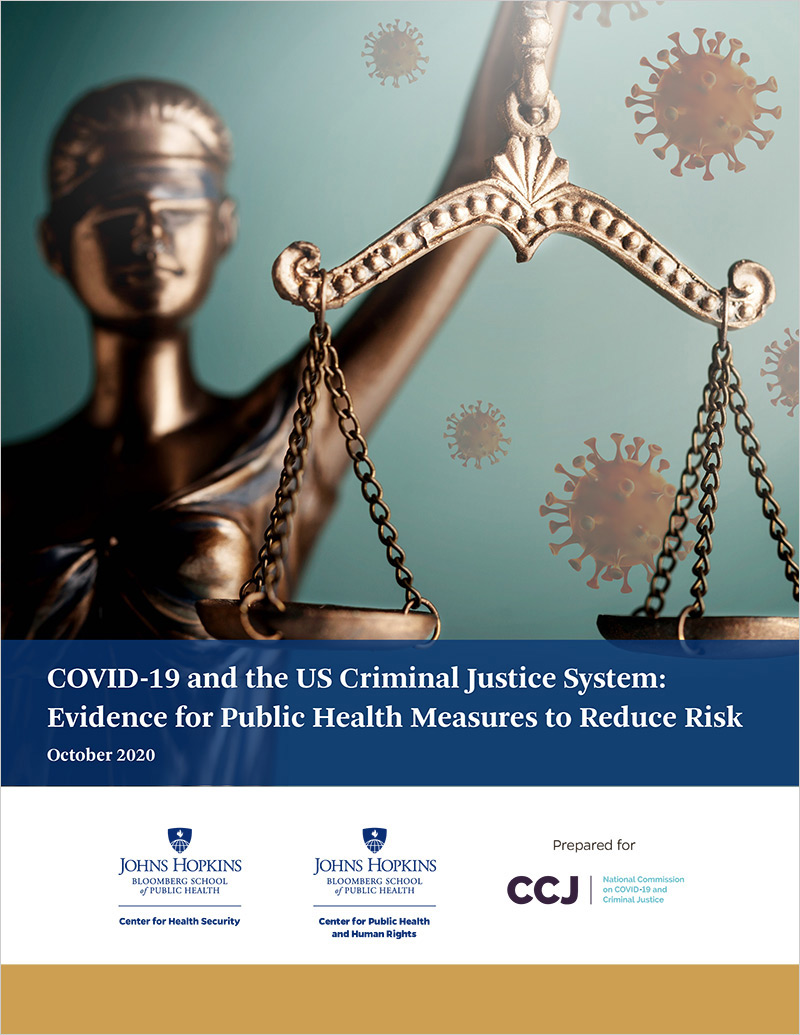New Report: COVID-19 and the U.S. Criminal Justice System: Evidence for Public Health Measures to Reduce Risk
Changes are urgently needed in the U.S. criminal justice system to diminish the risk of COVID_19 transmission and provide the standard of care to those who have been infected with this disease
Center News

October 15, 2020 – The Johns Hopkins Center for Health Security and the Center for Public Health and Human Rights at Johns Hopkins Bloomberg School of Public Health released a new report detailing the impacts of COVID-19 on the nation’s criminal justice system, COVID-19 and the U.S. Criminal Justice System: Evidence for Public Health Measures to Reduce Risk.
The report, prepared in partnership with the National Commission on COVID-19 and Criminal Justice, provides evidence-based recommendations to reduce the risk of infection for people who work in and are confined by the system.
According to the new report, COVID-19 outbreaks are growing fast in carceral facilities (jail, prisons, and detention centers). As of June 6, 2020, the COVID-19 case rate in prisons was 5.5 times higher and the age-adjusted death rate was three times higher than that of the overall U.S. population.
“The U.S. criminal justice system is highly susceptible to the spread of COVID-19 because of the structure of carceral facilities, which propagates the spread of respiratory infections, and the comorbidities of many incarcerated individuals,” say the authors. They also state that the COVID-19 pandemic poses a great threat to staff members who work at these facilities and the broader criminal justice system. “The current system and operations of facilities of incarceration are not able to protect incarcerated individuals from COVID-19. Changes are urgently needed to diminish the risk of transmission and provide the standard of care to those who have been infected with this disease.”
The 8 recommendations for jails, prisons and detention centers in this new report from Johns Hopkins are:
- Reduce population density of carceral facilities by limiting pretrial detention other than when an individual has made credible, serious threats of violence or flight from prosecution; expediting release or parole for all older incarcerated individuals and those with chronic conditions that predispose them to severe COVID-19 disease.
- Reexamine the relationship between health and incarceration in decisions of bail, sentencing and release.
- Make SARS-CoV-2 testing results and prevention strategies public.
- Conduct widespread and continuous SARS-CoV-2 viral testing.
- Implement quarantine and medical isolation strategies to respond to active SARS-CoV-2 cases.
- Modify facility practices and procedures to prevent SARS-CoV-2 spread.
- Standardize healthcare services in carceral facilities to ensure incarcerated people have access to standard care for COVID-19.
- When a safe and effective SARS-CoV-2 vaccine becomes available, prioritize vaccination access to incarcerated individuals and staff working in carceral facilities, equivalent to prioritizing vaccination in other high-risk congregate care settings like nursing homes.
The 3 recommendations for courts are:
- Implement alternatives to in-person court appearances when possible.
- Provide adequate access to technology in carceral facilities for virtual court appearances.
- When in-person court proceedings must occur, they should be conducted in a way that ensures adequate physical distancing for staff, defendants, and juries; all should wear masks.
COVID-19 and the U.S. Criminal Justice System: Evidence for Public Health Measures to Reduce Risk is one in a series of research documents requested by the independent Commission, which was established by the Council on Criminal Justice and is co-chaired by former U.S. Attorneys General Loretta Lynch and Alberto Gonzales. Featuring the latest available data on the coronavirus and how it spreads, the report helped shape the Commission’s newly released interim recommendations, which provide guidance to justice system leaders working to balance public health and public safety.
